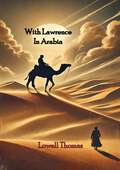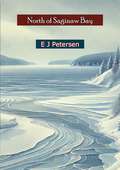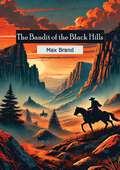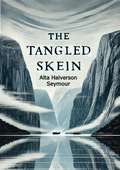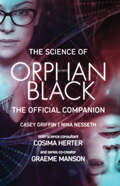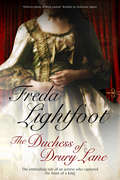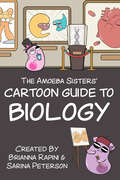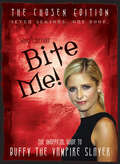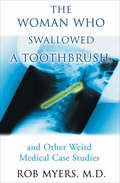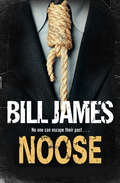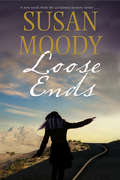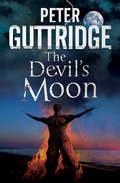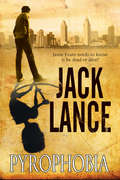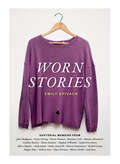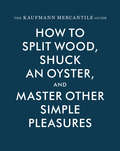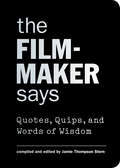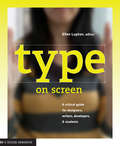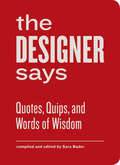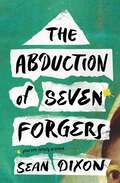- Table View
- List View
With Lawrence In Arabia
by Lowell ThomasLowell Thomas’ With Lawrence in Arabia is a captivating chronicle of one of the most legendary figures of World War I, T.E. Lawrence, famously known as "Lawrence of Arabia." Written by the journalist and broadcaster who helped immortalize Lawrence’s exploits, this book offers a thrilling firsthand account of the Arab Revolt and Lawrence’s extraordinary role in it.Thomas vividly recounts his experiences traveling through the deserts of the Middle East, where he witnessed the daring campaigns and remarkable leadership of Lawrence as he united disparate Arab tribes in their fight against the Ottoman Empire. From camelback raids to explosive battles, the narrative captures the drama, danger, and romance of desert warfare.Beyond the action, With Lawrence in Arabia delves into the complexities of Lawrence’s character—a scholar, strategist, and enigmatic leader who inspired loyalty and admiration but was also deeply conflicted about his role in shaping the destiny of the Arab world. Thomas paints a richly detailed portrait of both the man and the Middle Eastern landscapes that served as the backdrop for his exploits.Accompanied by vivid descriptions and photographs taken during Thomas’ travels, this book is both a gripping adventure story and a valuable historical document that sheds light on a critical moment in Middle Eastern and world history.Perfect for history enthusiasts, fans of epic tales, and those fascinated by larger-than-life figures, With Lawrence in Arabia is a timeless account of courage, strategy, and the enduring impact of one man’s vision in a changing world.
Confessions of the Old Wizard: The Autobiography of Hjalmar Horace Greeley Schacht
by Hjalmar Horace Greeley SchachtConfessions of the Old Wizard: The Autobiography of Hjalmar Horace Greeley Schacht offers a fascinating and candid account of one of the most enigmatic and influential figures in 20th-century European finance and politics. Known as "the Old Wizard" for his financial acumen, Schacht played a pivotal role in stabilizing the German economy during the interwar period and later became a controversial figure due to his involvement with the Nazi regime.In this compelling memoir, Schacht recounts his remarkable career, beginning with his early life and education, which shaped his economic philosophy and pragmatic approach to fiscal policy. He provides a firsthand account of his tenure as President of the Reichsbank and Minister of Economics, detailing his efforts to combat hyperinflation, revive the German economy, and negotiate reparations after World War I.Schacht also addresses his uneasy relationship with Adolf Hitler and the Nazi leadership, offering insights into his disagreements with their policies and his eventual dismissal. His reflections on the trials at Nuremberg, where he was acquitted of war crimes, provide a unique perspective on one of history’s darkest periods.With a mix of self-reflection, historical commentary, and personal anecdotes, Confessions of the Old Wizard sheds light on the complexities of Schacht’s life and legacy. It reveals the intricate interplay between economics, politics, and morality during times of national and global upheaval.This autobiography is an essential read for those interested in economic history, the dynamics of power, and the moral dilemmas faced by individuals in positions of influence. Schacht’s narrative offers a rare glimpse into the life of a man who shaped—and was shaped by—the turbulent events of his time.
North of Saginaw Bay
by E J PetersenE. J. Petersen’s North of Saginaw Bay is a captivating tale set in the rugged and picturesque landscapes of Michigan’s northern shores. Blending vivid descriptions of nature with a compelling narrative, Petersen captures the spirit of life along the bay, where resilience and resourcefulness are as vital as the beauty of the surrounding wilderness.The story follows a diverse cast of characters whose lives intertwine in a community shaped by the challenges and rewards of life near Saginaw Bay. Through trials of love, loyalty, and ambition, the novel explores themes of human connection, the power of place, and the enduring relationship between people and the natural world.Petersen’s evocative writing brings the region to life, from the serene waters of the bay to the dense, untamed forests that stretch beyond its shores. Against this striking backdrop, the struggles and triumphs of the characters unfold, revealing the strength of their bonds and the determination needed to thrive in a remote and often unforgiving environment.Rich in atmosphere and steeped in the culture and history of northern Michigan, North of Saginaw Bay is a moving and unforgettable story that celebrates the beauty of the land and the spirit of the people who call it home. This novel will resonate with readers who appreciate tales of resilience, community, and the profound influence of nature on human life.
Risk, Uncertainty and Profit
by Frank KnightFrank Knight’s Risk, Uncertainty and Profit is a groundbreaking work in economic theory that explores the essential role of risk and uncertainty in the functioning of markets and the generation of profit. First published in 1921, this classic text remains a cornerstone of economic thought, offering profound insights into the dynamics of entrepreneurship, decision-making, and market structures.Knight distinguishes between measurable risk, which can be calculated and managed, and true uncertainty, which is unquantifiable and shapes the very nature of profit and entrepreneurship. He argues that it is the presence of uncertainty that gives rise to profit as entrepreneurs take on the challenge of navigating unpredictable environments, allocating resources, and making strategic decisions.The book also delves into the conditions for perfect competition and examines how economic behavior is influenced by institutional frameworks, human motivation, and the social context of markets. Knight’s incisive analysis lays the foundation for understanding the complexities of modern economics, particularly in relation to the role of innovation, competition, and the allocation of resources in an uncertain world.Renowned for its intellectual rigor and clarity, Risk, Uncertainty and Profit is essential reading for economists, scholars, and anyone interested in the underlying principles that govern market behavior. Knight’s work continues to influence economic theory and policy, making it as relevant today as when it was first published.Accessible yet intellectually challenging, this book offers timeless insights into the mechanisms of capitalism and the enduring impact of uncertainty on economic life.
The Bandit of the Black Hills
by Max BrandMax Brand’s The Bandit of the Black Hills is a thrilling Western adventure filled with danger, intrigue, and the enduring fight for justice. Set against the rugged and wild backdrop of the Black Hills, this classic tale captures the essence of the frontier, where law and order are fragile and courage is the ultimate currency.The story follows a mysterious outlaw whose reputation as a bandit strikes fear into the hearts of settlers and lawmen alike. But as whispers of his exploits spread, it becomes clear that there’s more to this enigmatic figure than meets the eye. When a determined young hero crosses paths with the infamous bandit, their fates become intertwined in a high-stakes battle against corruption, greed, and betrayal.Brand’s masterful storytelling brings the Black Hills to life, with vivid landscapes and dynamic characters that leap off the page. As the plot unfolds, readers are drawn into a world of secret identities, daring escapes, and unexpected alliances. The novel’s fast-paced action and moments of heartfelt emotion make it a standout in the Western genre.The Bandit of the Black Hills is a testament to Max Brand’s legendary skill as a writer, blending compelling narrative with themes of redemption, loyalty, and the pursuit of justice. Perfect for fans of classic Westerns and timeless tales of heroism, this novel delivers an unforgettable journey into the heart of the American frontier.
The Tangled Skein
by Alta Halverson SeymourAlta Halverson Seymour’s The Tangled Skein is a beautifully crafted historical novel that weaves a tale of mystery, relationships, and the complexities of human emotion. Set in a richly detailed past, the story captures the essence of a world in transition, where tradition and modernity collide, and personal destinies are as intricately interwoven as the threads of a skein.The novel follows a young protagonist whose life takes an unexpected turn when a series of events forces them to confront long-buried secrets and unforeseen challenges. Through encounters with an array of vividly drawn characters, the story delves into themes of loyalty, self-discovery, and the enduring power of connection.Seymour’s evocative prose brings the setting to life, immersing readers in the sights, sounds, and sentiments of the time. The title’s metaphor of a “tangled skein” reflects the intricacies of the characters’ lives as they navigate conflicts, relationships, and the pursuit of their true paths. As the story unfolds, the characters’ struggles and triumphs resonate with timeless relevance, offering a poignant exploration of resilience and hope.Perfect for fans of historical fiction and character-driven narratives, The Tangled Skein is a masterful blend of intrigue and heart. Seymour’s skillful storytelling and attention to detail make this novel a memorable and engaging journey into a world where the threads of life, though tangled, reveal a beautiful pattern when viewed as a whole.
The Heart of the Matter: Questions to Ask Your Cardiologist
by Sandra Jordan Douglas WestveerIf you're browsing through The Heart of the Matter, the threat of cardiac disease is lurking in your mind, and with good reason. Although national programs to contain this killer are highly successful and ahead of schedule, heart disease remains highly prevalent and deadly. Medical research during the last 15 years has successfully defined many treatment strategies that work, and many that don't. Your task is not to understand this mountain of information, but to know the critical questions to ask your doctor when you are in trouble. The Heart of the Matter will highlight for you the right questions to ask after your heart attack, or if you're afflicted by hypertension, high cholesterol, or heart failure. Before you need a pacemaker, defibrillator, heart surgery, or angioplasty, the right questions need to be asked, and you'll find out why they're important. Take advantage of all of the recent research and years of clinical experience by the authors in managing heart disease.
The Science of Orphan Black: The Official Companion
by Casey Griffin Nina Nesseth Cosima Herter Graeme MansonAn official guide to the crazy science of Orphan Black—from cloning to chimerism and much more. Delve deeper into the scientific terms and theories at the core of the Peabody-winning cult-favorite show. With exclusive insights from the show&’s co-creator Graeme Manson and science consultant Cosima Herter, The Science of Orphan Blacktakes you behind the closed doors of the Dyad Institute and inside Neolution, with color photos included. Authors Casey Griffin and Nina Nesseth decode the mysteries of Orphan Black—from the history of cloning, epigenetics, synthetic biology, chimerism, the real diseases on which the clone disease is based, and the transhumanist philosophies of Neolution, to what exactly happens when a projectile pencil is shot through a person&’s eye and into their brain.
The Duchess of Drury Lane (Home Front Detective Ser. #2)
by Freda LightfootPassion, jealousy, and scandal abound in this regency romance based on the real-life rags-to-riches story of British actress Dora Jordan. Having grown up poor and fatherless in Ireland, Dorothy Jordan is determined to overcome her humble beginnings and become the most famous comic actress of her day. While performing on London&’s Drury Lane, Dora catches the eye of the Duke of Clarence, the man who would become King William IV. Beginning a romance that will endure for twenty years—and produce ten children—Dora experiences great happiness with the Duke. But ultimately, Dora&’s generous nature becomes her undoing. Betrayed by the man she loves, Dora is faced with the harsh reality that life rarely resembles the happily-ever-afters of the plays she performs. An extraordinary woman born into extraordinary times, Dora Jordan&’s story is one of great passion and even greater pain. In The Duchess of Drury Lane, Freda Lightfoot reveals the true story of the rise and fall of an actress who captured the heart of a king. &“With a host of fleshed out characters, this fast-paced, biographical novel is pleasure to read and a great addition to historical fiction centered on royal personages.&” —Historical Novel Society
The Amoeba Sisters' Cartoon Guide to Biology
by Brianna Rapini Sarina Peterson24 Major Biology Topics You Should KnowExplore the wonders of biology inside and outside of the classroom with The Amoeba Sisters’ Cartoon Guide to Biology. Science facts made easy. From the dynamic sister duo behind the beloved Amoeba Sisters YouTube channel, this visual learning book features 24 major educational concepts commonly taught in life sciences courses. Designed to alleviate the intimidation often associated with complex science concepts, this guide employs amusing mnemonics, real-world examples, and light-hearted humorous anecdotes to make biology topics more approachable and relatable.Designed for anyone studying biology. Whether you’re a high school student, a college scholar, or a curious biology enthusiast, this book ensures that learning biology remains engaging and accessible for all ages to enjoy. This book tackles topics students often find difficult, such as cell transport, cellular respiration, protein synthesis, DNA replication, mitosis, and meiosis, with each chapter addressing stumbling blocks they may encounter in the classroom or during study prep. Whether used as an introduction to a concept or to recap a lesson, this book also makes a great supplement to your biology textbook as a classroom set.Pairs well with any biology course.Illustrations, diagrams, and cartoons break down complex biology conceptsShort chapters provide a biology foundation in the style of Amoeba Sisters videosUseful for teachers and students, includes objectives at end of each chapter to help with test preparationGlossary of over 250 biology vocabulary words with easy-to-understand, brief definitionsSo if you enjoy teen and kid science books such as Physics for Curious Kids, Awesome Facts That Will Make You Look Super Smart, or Noah’s Fascinating World of STEAM Experiments, then you’ll love The Amoeba Sisters’ Cartoon Guide to Biology.
Bite Me!: The Unofficial Guide to Buffy the Vampire Slayer
by Nikki StaffordTake a deep dive into the TV series that brought us all into the Buffyverse—including an episode guide, a trivia quiz, cast bios, and more! It&’s been more than a decade since Buffy Summers first walked into the Sunnydale High library and came face-to-face with her Watcher, who told her she was the Chosen One who would save the world from vampires. In the seven seasons that Buffy the Vampire Slayer was on TV, we watched her kill her true love (but he got better), graduate high school (by blowing it up), discover she had a sister (who . . . uh . . . was always there?), sacrifice her own life (but she got better), watch her sidekicks become heroes (and villains), and, essentially, grow up. Bite Me!, Nikki Stafford&’s critical analysis of the show, was one of the bestselling and most critically acclaimed books on Buffy when it was released in 2002. Current up to season 6, the book examined Buffy&’s development, and outlined the mythical, religious, and historical backgrounds to the episodes. Nikki&’s guide to season 7 appeared in her Angel book, but there was never one place where fans could get their Buffy fix all in one place. Until now. Revised and updated, the 10th Buffyversary edition of Bite Me! contains all seven seasons of this groundbreaking series, chronicles what happened to all of its stars, gives the background story to why the series ended and what legacy it has had, and even contains information about the new Buffy &“season eight&” comic book series from Dark Horse. Bite Me! is the definitive guide for all Buffy fans.
The Woman Who Swallowed a Toothbrush: And Other Bizarre Medical Cases
by Rob MyersDrawing from real medical journal cases, a doctor shares true stories about strange symptoms and perplexing patients. Those in the medical profession know that sometimes the cases that come into emergency rooms or doctor&’s offices can be highly unusual—and depending on how things go, the results can be either tragic or comic. This collection of stories reveals some of the oddest and most memorable case histories, from the woman who claims she was brushing her teeth when she swallowed her toothbrush—but in fact was a bulimic using it to induce vomiting—to the man whose routine elective back surgery revealed he&’d been carrying a bullet around in his body for years. From the funny to the frightening, these documented memorable medical mysteries make for fascinating reading.
Noose
by Bill James&“James, who may be one of Britain&’s most underrated crime fiction writers, produces a shocker packed with menace and very black humor.&” —Booklist, starred review Britain, 1956. A young actress seemingly tries to commit suicide over a tangled love affair, but is taken to the hospital and her life saved. The story is just the sort of thing that journalist Ian Charteris likes to cover: a poignant mix of near tragedy, possible thwarted romance, and glamour, needing sensitive but—of course—dramatic treatment. It should be a routine assignment, a welcomed assignment. It would be, if it weren&’t for the identity of the young woman. She may—just may—be Ian&’s sister. The unwelcomed reminder of the past drags Ian back into memories of places and events he&’d rather forget. As far as Ian is concerned, the past is a foreign country. And not just foreign. Fundamentally and cantankerously hostile. Vengeful, war-torn, dangerous. It is impossible to escape the past; the noose is already around Ian&’s neck, and every step he takes tightens it . . . And this is not the only noose. &“James spins an effective psychological tale of a man whose past shapes his future.&” —Publishers Weekly
Loose Ends
by Susan MoodyThe past lives of two London strangers converge in this &“addictive, ironic and darkly suspenseful combination of mystery and romance&” (Kirkus Reviews). It&’s been ten years since Kate Fullerton survived a suspicious car accident in Ecuador that took the lives of her father, stepmother, and younger sister. Haunted by the tragedy, and with her inheritance lost to a con artist husband, Kate&’s been adrift ever since. She only begins to feel on solid ground again when she secures a job at a travel agency and agrees to share a comfortable apartment with her accommodating new boss. If only she could shake the feeling that she&’s being followed. Then, a decomposed body is found floating in a nearby canal. And a handsome amateur detective solicits her help in booking passage for a vacation getaway—in South America. Kate may have thought she was pulling her life together. Instead, it&’s her past that&’s slowly coming into focus. For Kate, that&’s a very dangerous thing. Loose Ends &“is Moody at her best. An outstanding psychological thriller&” about the secrets that bind us, and those that can kill (Booklist).
The Devil's Moon (Brighton Series #4)
by Peter GuttridgeThe Brighton series continues and &“takes a turn towards the occult&” with &“well-wrought prose, an appealing new character . . . and a deadly climax&” (Booklist). Something strange is in the Brighton air. Everywhere newly-promoted Sarah Gilchrist looks, unsettling things are happening. A Wicker Man is burned on the beach at dawn with a body inside; a painting titled The Devil&’s Altar is stolen from the Brighton Museum; a vicar who casts out demons goes missing; and a rare medieval manuscript of the occult Key of Solomon is stolen from the Jubilee Library. Then Gilchrist&’s flatmate, Kate Simpson, discovers that acts of sacrilege and grave robbing have been routinely taking place in Brighton and the surrounding villages. And ex-Chief Constable Bob Watts is puzzling over inscriptions in his late father&’s books. Specifically, books by occult writers Dennis Wheatley, Colin Pearson—and the feared Aleister Crowley, cremated in Brighton in 1947. Old Religion and New Age collide and the body count mounts as the Devil&’s Moon slowly rises . . . &“Guttridge&’s fourth dispatch from Brighton features many of the same characters as the first three but is more cerebral and slower paced. In its own different way, however, it&’s just as literate and exciting.&” —Kirkus Reviews
Pyrophobia
by Jack LanceJason Evans has a perfect life—until he starts receiving messages that claim he&’s dead—in this haunting mystery from the bestselling Dutch author of Zone. Despite his fear of fire, life has been smooth sailing for Jason Evans. He has a loving wife, Kayla, a good job, and plenty of friends. There&’s nothing standing in the way of his happiness, until an unknown enemy starts sending him strange photographs. The chilling images of a graveyard all have ominous and perplexing messages on the back: &“You are dead. You think you&’re alive, but you don&’t exist.&” Jason&’s attempt to find out who&’s behind the disturbing missives leads him down an increasingly dark and dangerous path—one that makes him realize his life isn&’t as picture-perfect as he thinks. Tense and psychologically gripping, Pyrophobia is a horror story that takes one man into the darkest corners of his own mind . . .
The War Against Tuberculosis: Samuel G. Dixon and the Rise of Modern Public Health in Pennsylvania (Keystone Books)
by James E. HigginsIn 1905, sanitary conditions in Pennsylvania were appalling. Thousands of children died of preventable and curable diseases, tens of thousands in the coal regions hacked themselves to death from black lung disease, and pollution in the commonwealth’s water killed tens of thousands more. In the wake of an alarming typhoid outbreak in Butler, the Pennsylvania legislature formed a modern state department of health. At its head was Samuel G. Dixon, who would rise to fame as one of the most respected public health experts of his day.While the legislation that created Pennsylvania’s department of health cleared space for its aggressive action, it was Dixon’s deft political touch and keen insight that enabled the department to avoid destruction at the hands of a people notoriously hostile to government encroachment. As commissioner, Dixon constructed the world’s largest, most sophisticated system of tuberculosis controls, with thousands of beds in three great sanatoria. As his reputation grew, Dixon was recognized as one of the nation’s greatest public health reformers and a champion of technology as the answer to great societal problems. At the same time, Dixon was a eugenicist who helped author a marriage law prohibiting unions between the diseased, those with intellectual disabilities or psychiatric disorders, alcoholics, and the “unfit.”This compelling history of Pennsylvania’s first commissioner of public health provides a fascinating view into the changes wrought by germ theory and the public health efforts that stemmed from it during the Progressive Era in the United States.
Worn Stories
by Emily SpivackNew York Times Bestseller!Now a Netflix original seriesEveryone has a memoir in miniature in at least one piece of clothing. In Worn Stories, Emily Spivack has collected over sixty of these clothing-inspired narratives from cultural figures and talented storytellers. First-person accounts range from the everyday to the extraordinary, such as artist Marina Abramovic on the boots she wore to walk the Great Wall of China; musician Rosanne Cash on the purple shirt that belonged to her father; and fashion designer Cynthia Rowley on the Girl Scout sash that informed her business acumen. Other contributors include Greta Gerwig, Heidi Julavits, John Hodgman, Brandi Chastain, Marcus Samuelsson, Piper Kerman, Maira Kalman, Sasha Frere-Jones, Simon Doonan, Albert Maysles, Susan Orlean, Andy Spade, Paola Antonelli, David Carr, Andrew Kuo, and more. By turns funny, tragic, poignant, and celebratory, Worn Stories offers a revealing look at the clothes that protect us, serve as a uniform, assert our identity, or bring back the past—clothes that are encoded with the stories of our lives.
The Kaufmann Mercantile Guide: How to Split Wood, Shuck an Oyster, and Master Other Simple Pleasures
by Sebastian Kaufmann Alexandra RedgraveModern living isn't easy. It often seems to require some know-how our parents didn't pass on, or a special tool. Happily, Kaufmann Mercantile has both, and in this comprehensive field guide, they share their expertise on a huge range of topics, from frying an egg, tying a tie, or brewing coffee to things the inner utilitarian in all of us aspires to do, like splitting wood, building a fire, growing our own food, or making our own soap. Fifty how-tos are organized into five sections: Kitchen, Outdoors, Home, Garden, and Grooming. Written in clear detail and extensively illustrated, The Kaufmann Mercantile Guide teaches us what we ought to know how to do, as well as what we'd like to. Supplemental sidebars feature the best tool for the job, whether a dibber for planting, the best rawhideand- ash snowshoes, or flammable smoking bags for making authentic BBQ. This book is a must-have reference tool for living well in the twenty-first century.
Sustainable Design: A Critical Guide (Architecture Briefs)
by David BergmanWritten for students and practitioners in the fields of architecture and interior design, our new Architecture Brief Sustainable Design provides a concise overview of all the techniques available for reducing the energy footprint of structures and spaces. With clear, simple language and a practical "can-do" approach, author David Bergman covers everything from the profession's ethical responsibility, to design structures and spaces that sustain our natural resources, to specific considerations such as rainwater harvesting, graywater recycling, passive heating techniques, solar orientation, green roofs, wind energy, daylighting, indoor air quality, material evaluation and specification, and how to work with green building certification programs.
The Filmmaker Says: Quotes, Quips, and Words of Wisdom (Words of Wisdom)
by Jamie Thompson SternInspiring everything from pop culture earthquakes to popular revolutions, filmmakers have demonstrated an uncanny ability to move the masses. But the drama they project on screen is only half the picture. Stretching from its earliest days of two-reel silent films to the latest 3-D digital blockbusters, film history provides a cast of characters ready to spill witty bon mots, outrageous pronouncements, and heartfelt reflections. The Filmmaker Says is a colorful compendium of quotations from more than one hundred of history's most influential and opinionated creators of filmed entertainment. Paired like guests at the ultimate film geek dinner party, a celebrated filmmaker of today might sit next to a giant from the silent era, this raucous crew puts on a show arguing, complimenting, and disagreeing with each other about every step of the moviemaking process. A perfect gift for working filmmakers, aspiring auteurs, and avid moviegoers, The Filmmaker Says will delight anyone who has'dreamed of yelling "action" or just can't wait for the lights to go down and the curtain to go up.
Type on Screen: A Critical Guide for Designers, Writers, Developers, and Students (Design Briefs Ser.)
by Maryland Institute College of Art Ellen LuptonThe long awaited follow-up to our all-time bestseller Thinking with Type is here. Type on Screen is the definitive guide to using classic typographic concepts of form and structure to make dynamic compositions for screen-based applications. Covering a broad range of technologies—from electronic publications and websites to videos and mobile devices—this hands-on primer presents the latest information available to help designers make critical creative decisions, including how to choose typefaces for the screen, how to style beautiful, functional text and navigation, how to apply principles of animation to text, and how to generate new forms and experiences with code-based operations. Type on Screen is an essential design tool for anyone seeking clear and focused guidance about typography for the digital age.
The Designer Says: Quotes, Quips, and Words of Wisdom (Words of Wisdom)
by Sara BaderWhether musing about the creative process, the merits of failure and criticism, or the challenges of keeping the studio lights on, designers make good, and opinionated, copy. The Designer Says, the follow-up to our best-selling The Architect Says, is a compendium of quotations from more than one hundred of history's leading practitioners. Quotes are paired on page spreads like guests at a dinner party. A designer from the nineteenth century might sit next to one working today or two contemporary designers may strike up a conversation. Listen in as they compliment, provoke, and one-up each other in this lively volume of insights.
The Toaster Project: Or A Heroic Attempt to Build a Simple Electric Appliance from Scratch
by Thomas Thwaites"Hello, my name is Thomas Thwaites, and I have made a toaster." So begins The Toaster Project, the author's nine-month-long journey from his local appliance store to remote mines in the UK to his mother's backyard, where he creates a crude foundry. Along the way, he learns that an ordinary toaster is made up of 404 separate parts, that the best way to smelt metal at home is by using a method found in a fifteenth-century treatise, and that plastic is almost impossible to make from scratch. In the end, Thwaites's homemade toaster—a haunting and strangely beautiful object—cost 250 times more than the toaster he bought at the store and involved close to two thousand miles of travel to some of Britain's remotest locations. The Toaster Project may seem foolish, even insane. Yet, Thwaites's quixotic tale, told with self-deprecating wit, helps us reflect on the costs and perils of our cheap consumer culture, and in so doing reveals much about the organization of the modern world.
The Abduction of Seven Forgers
by Sean Dixon"One day, not long ago, I was kidnapped by a bitter but fun-loving South Korean art collector named Mr. Jackie Lin who had been burned one too many times by art forgers and wanted a bit of revenge." So begins The Abduction of Seven Forgers, a brilliant and immensely entertaining novel with a colourful and unforgettable cast of characters. A group of artists are brought together under mysterious circumstances to a leafy London suburb. Once there, they are taken hostage by Mr. Lin, an angry art collector who demands that they create original works that will replace the forgeries he has obtained from each of them in the past. Over the following days, the hostages discover that a twelve-year-old boy is hiding in crawl spaces behind the walls, and they agree to continue to keep him hidden from Mr. Lin. But things become immensely more complicated once Mr. Lin's daughter appears, purportedly to learn from the forgers -- there may be more to Mr. Lin's artistic plan than first meets the eye. With dazzling inventiveness, Sean Dixon explores the power of art, both in its creation and its acquisition, and creates a vivid world where artworks can -- and do -- come to life. The Abduction of Seven Forgers brings together the artistic obsession of The Goldfinch, the stakes of Bel Canto, and the intelligent imagination demonstrated by Yann Martel and David Mitchell, with a flair that is all Sean Dixon's own.
